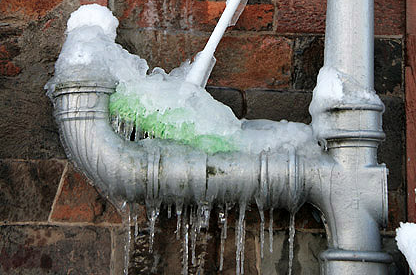How to Protect Pipes from Freezing Damage: Crucial Advice
How to Protect Pipes from Freezing Damage: Crucial Advice
Blog Article
What're your thoughts on Preventing and dealing with frozen pipes?
:strip_icc()/snow-outdoor-faucet-pipes-4af65d1e5e904fb1aa7bf74071fe5d89.jpg)
Cold weather can ruin your pipes, specifically by freezing pipelines. Here's just how to prevent it from happening and what to do if it does.
Intro
As temperature levels decline, the danger of frozen pipelines increases, potentially causing costly repair services and water damages. Understanding how to prevent icy pipes is important for home owners in cold climates.
Comprehending Icy Pipelines
What triggers pipes to ice up?
Pipes freeze when subjected to temperature levels listed below 32 ° F (0 ° C) for extended periods. As water inside the pipelines freezes, it increases, taxing the pipe walls and possibly triggering them to break.
Threats and problems
Frozen pipes can lead to supply of water interruptions, property damages, and costly repair work. Burst pipelines can flood homes and trigger considerable architectural damage.
Signs of Frozen Water Lines
Identifying frozen pipes early can avoid them from bursting.
Just how to determine icy pipelines
Try to find decreased water circulation from taps, unusual odors or sounds from pipelines, and noticeable frost on subjected pipelines.
Avoidance Tips
Shielding vulnerable pipes
Cover pipelines in insulation sleeves or make use of warm tape to safeguard them from freezing temperature levels. Concentrate on pipes in unheated or external locations of the home.
Home heating strategies
Maintain indoor spaces adequately heated, specifically areas with pipes. Open up cabinet doors to allow cozy air to flow around pipelines under sinks.
Protecting Exterior Plumbing
Yard pipes and outdoor faucets
Detach and drain yard pipes prior to winter months. Install frost-proof spigots or cover outdoor faucets with protected caps.
What to Do If Your Pipes Freeze
Immediate actions to take
If you believe frozen pipelines, maintain faucets available to soothe pressure as the ice thaws. Use a hairdryer or towels soaked in hot water to thaw pipes slowly.
Long-Term Solutions
Architectural adjustments
Take into consideration rerouting pipelines away from outside wall surfaces or unheated areas. Add extra insulation to attics, cellars, and crawl spaces.
Updating insulation
Buy high-grade insulation for pipes, attic rooms, and wall surfaces. Appropriate insulation assists maintain constant temperature levels and minimizes the danger of frozen pipelines.
Verdict
Stopping frozen pipelines needs positive steps and fast actions. By comprehending the reasons, indications, and safety nets, property owners can secure their pipes during winter.
5 Ways to Prevent Frozen Pipes
Drain Outdoor Faucets and Disconnect Hoses
First, close the shut-off valve that controls the flow of water in the pipe to your outdoor faucet. Then, head outside to disconnect and drain your hose and open the outdoor faucet to allow the water to completely drain out of the line. Turn off the faucet when done. Finally, head back to the shut-off valve and drain the remaining water inside the pipe into a bucket or container. Additionally, if you have a home irrigation system, you should consider hiring an expert to clear the system of water each year.
Insulate Pipes
One of the best and most cost-effective methods for preventing frozen water pipes is to wrap your pipes with insulation. This is especially important for areas in your home that aren’t exposed to heat, such as an attic. We suggest using foam sleeves, which can typically be found at your local hardware store.
Keep Heat Running at 65
Your pipes are located inside your walls, and the temperature there is much colder than the rest of the house. To prevent your pipes from freezing, The Insurance Information Institute suggests that you keep your home heated to at least 65 degrees, even when traveling. You may want to invest in smart devices that can keep an eye on the temperature in your home while you’re away.
Leave Water Dripping
Moving water — even a small trickle — can prevent ice from forming inside your pipes. When freezing temps are imminent, start a drip of water from all faucets that serve exposed pipes. Leaving a few faucets running will also help relieve pressure inside the pipes and help prevent a rupture if the water inside freezes.
Open Cupboard Doors
Warm your kitchen and bathroom pipes by opening cupboards and vanities. You should also leave your interior doors ajar to help warm air circulate evenly throughout your home.

I hope you liked our excerpt on How to prepare your home plumbing for winter weather. Thanks for finding the time to read through our piece. Sharing is nice. Helping others is fun. Kudos for your time. Kindly come by our blog back soon.
Click On This Link Report this page